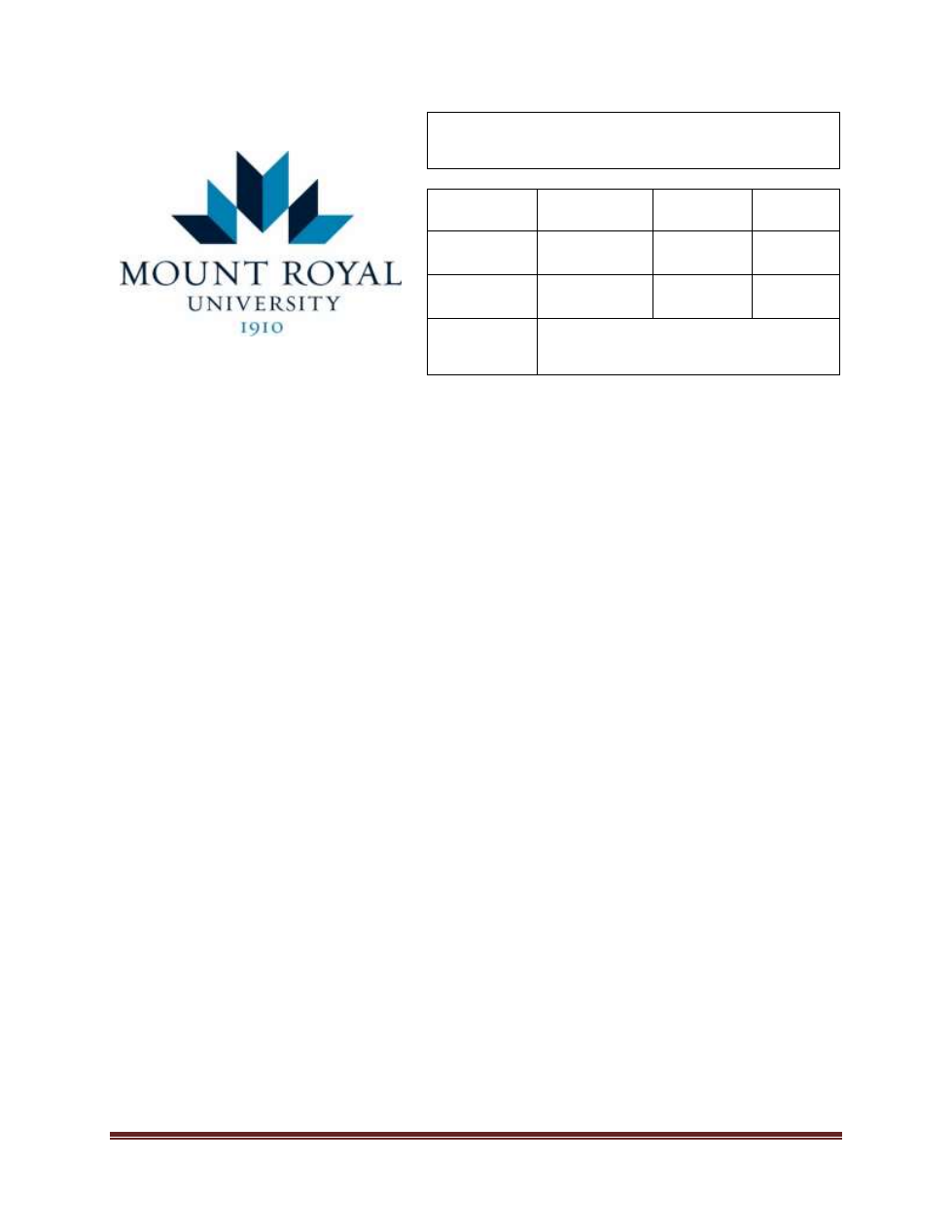
Procedure for Investigating a Protected Disclosure
– October 14, 2020
Page 1 of 6
PROCEDURE
FOR
INVESTIGATING
A
PROTECTED
DISCLOSURE
Procedure
Type:
Management
Initially
Approved:
October 14,
2020
Procedure
Sponsor:
General Counsel
and University
Secretary
Last Revised:
April 1, 2021
Administrative
Responsibility:
General Counsel
and University
Secretary
Review
Scheduled:
October 14,
2025
Approver:
Executive Leadership Team
A.
PROCEDURES
1.
INVESTIGATING A PROTECTED DISCLOSURE
1.1
Once the Designated Officer has determined that a Protected Disclosure falls within
the parameters of the Policy and determined through the Procedure for Filing a
Protected Disclosure that an investigation is warranted, an investigation into the
allegation will be initiated.
1.2
Investigations will be conducted in a timely and objective manner in accordance with
processes that:
a. adhere to the principles of procedural fairness and natural justice;
b. are conducted with due diligence and do not pre-judge an outcome; and
c. are free from bias.
1.3
The investigation may be conducted by the Designated Officer, an external
investigator determined by the Designated Officer, or by an appropriate Department
determined by the Designated Officer. If required, the Designated Officer may also
form an investigation team to conduct the investigation.
a. in any of these cases, the Designated Officer will approve the scope and terms
of reference of the investigation.
b. the scope and terms of reference may be revised by the Designated Officer if,
during an investigation, information assessed by the investigator results in the
potential for alleging other Wrongdoings unrelated to the initial allegation. At the
discretion of the Designated Officer, the investigator may investigate any
potential Wrongdoings as part of the ongoing investigation, or a separate
investigation may be initiated to investigate those potential Wrongdoings.
1.4
In all situations, the Designated Officer will be responsible and accountable for the
timely completion of the investigation. All investigations must be completed, and a
final report made to the Chief Officer, within 120 business days of receipt of the
Protected Disclosure. The Designated Officer may ask the Chief Officer for a 30-day
extension should additional time be necessary to complete the investigation
appropriately in the interest of a fair and efficient outcome. Further time extensions

Procedure for Investigating a Protected Disclosure
– October 14, 2020
Page 2 of 6
may be granted by the Commissioner if such a request is made by the Designated
Officer. The discloser will be updated on the time extension for completion of the
investigation.
1.5
If the Designated Officer is the investigator of the Protected Disclosure, they will
prepare an investigation plan for inclusion in the case file prior to initiating the
investigation. If the Designated Officer appoints an investigator or investigation team,
the investigation plan must be approved by the Designated Officer. The Designated
Officer should communicate to the investigator or investigation team that the
investigation is initiated as a result of the protected disclosure. The investigation plan
includes:
a. the scope and terms of reference of the investigation as approved by the
Designated Officer;
b. what is being alleged;
c. what are the facts in issue;
d. How the investigation is to be conducted;
e. an initial list of interviewees who may be involved or have relevant information
pertaining to the Protected Disclosure;
f.
what resources are required; and
g. the anticipated timeline for an initial draft report to be completed.
1.6
If any external expertise is retained to assist in the investigation (e.g. lawyers,
specialized investigators, forensic auditors etc.) care will be taken to handle all
materials and correspondence to or from any expert, including billing for these
services.
1.7
As part of the investigation, and where reasonably required to complete an
investigation, the investigator(s) has the authority to:
a. access any University owned or operated space; and
b. access, examine, copy, and/or remove any Transitory Record or Official
Business Record under the control and custody of the University;
i.
The examination, copying, and/or removal does not require the consent
of the individual who might use or have custody of the property or
facilities.
ii.
This does not include research records and teaching materials of a
proprietary nature; where the intellectual property belongs to the faculty
member.
1.8
The Discloser may be contacted during the investigation to clarify any matters and/or
seek additional information.
1.9
At an appropriate time, as determined by the Designated Officer, any Employee
subject to an investigation will be advised of the nature of the allegations and given

Procedure for Investigating a Protected Disclosure
– October 14, 2020
Page 3 of 6
opportunity to respond. However, in investigating certain allegations of Wrongdoing
such as fraud, advance notice of initial investigations or interviews may be limited.
1.10
All Employees have an obligation to cooperate fully with an investigation.
Investigations will be conducted without preferential treatment based on the length
of service, position, or title of Employees against whom an allegation has been made.
2.
INVESTIGATION REPORT
2.1
When the investigation is complete, the investigator will submit a written report to the
Designated Officer that will include, but not limited to:
a. the allegation of Wrongdoing;
b. an account of the information assessed during the investigation and, if the
investigator has determined certain information as being not credible, the
reasons for determining why the information is not credible; and
c. findings of fact that, on a review of all the evidence, are assessed on a balance
of probabilities.
2.2
A final report will then be submitted to the Chief Officer by the Designated Officer. If
the investigator has found evidence of Wrongdoing, the final report may include
recommendations to be taken to prevent the conduct from continuing or occurring in
the future as well as action that should be taken to remedy any harm or loss arising
from the Wrongdoing.
2.3
The Designated Officer will communicate the results of the investigation to the
Discloser once the final report has been submitted to the Chief Officer.
2.4
Based on the final report, the Chief Officer will direct the applicable Executive Leader
to undertake any necessary further actions, including disciplinary action when
warranted. In advance of any disciplinary action the Associate Vice-President,
Human Resources, or designate, must be contacted to commence a disciplinary
process. If an Executive Leader is subject to any disciplinary action, the Chief Officer
will contact Human Resources directly to commence a disciplinary process.
2.5
Executive Leaders responsible for addressing any recommendations of the final
report must follow up with the Designated Officer or, when necessary, the Chief
Officer with actions taken relating to the recommendations. If no actions were taken,
the Executive Leader will advise why no actions we taken.
B.
DEFINITIONS
(1)
the Act:
means the Public Interest Disclosure (Whistleblower
Protection) Act (Alberta), as amended, and any
regulations thereunder
(2)
Chief Officer:
means the President and Vice-Chancellor
(3)
Department:
means a faculty within the Academic Division or a
department, unit or, group outside of the Academic
Division

Procedure for Investigating a Protected Disclosure
– October 14, 2020
Page 4 of 6
(4)
Designated Officer:
means the Chief Officer or an individual appointed by
the Chief Officer to manage and report on Protected
Disclosures made in accordance with this Policy and
related procedures
(5)
Discloser:
means any Employee who chooses to file a Protected
Disclosure in accordance with the Policy
(6)
Employee:
means individuals who are engaged to work for the
University under an employment contract, including but
not limited to faculty, staff, exempt, casual and
management employees
(7)
Executive Leaders:
The President and the Vice-President
(8)
Official Business Record:
means those records created, or received, during the
course of University business activities, which represent
the first complete and final record that is able to produce
the consequences, results or actions, intended by its
author or creator.
examples may include, but are not limited to, records:
-
required to support business operations
-
document and provide evidence of business
transactions
-
required by legislation
-
protect the rights of citizens or the University
-
provide
evidence
of
compliance
or
accountability
-
have archival value to the University or the
public.
-
emails that fulfill the purposes or activities
described above.
(9)
Policy:
means the Protected Disclosure (“Whistleblower”)
policy
(10)
Protected Disclosure:
means a written report of Wrongdoing made in good
faith by an Employee in accordance with the Act and this
Policy and related procedures
(11)
Transitory Record:
Means those records that have short-term business
value and are only required for a limited time to complete
a routine action. Transitory records can be securely
destroyed once they are no longer required without
referring to the University Records Retention Schedule.
Examples of Transitory Records may include, but not
limited to:
-
copies that are kept for reference purpose,
where the original or final record is maintained
by the department responsible for retaining the
final original record

Procedure for Investigating a Protected Disclosure
– October 14, 2020
Page 5 of 6
-
draft documents and working papers
-
records
created
within
an
electronic
communication system containing information
of routine value such as text messages, instant
chats or e-mail communication.
(12)
University:
means Mount Royal University
(13)
Wrongdoing:
Any activity or conduct engaged in by an Employee in or
relating to the University, as follows:
• engaging in, or counseling or directing someone
to engage in, the following: breaking the law
through contravening an Act or regulation
• any act or omission that creates a substantial
and specific danger to the life, health or safety
of individuals or substantial and specific danger
to the environment
• gross mismanagement of public funds, a public
asset, or the delivery of a public service
identified in the regulations
• gross mismanagement of employees through
conduct of a systemic nature that indicates a
problem in an
organization’s culture relating to
bullying, harassment or intimidation.
Any other Wrongdoing as defined by the Act or related
regulations.
C.
RELATED POLICIES
• Code of Conduct – Employees policy
• Integrity in Research and Scholarship policy
D.
RELATED LEGISLATION
• Public Interest Disclosure (Whistleblower Protection) Act, SA, 2012, cP-39.
E.
RELATED DOCUMENTS
• Protected Disclosure Form
• MRFA Collective Agreement
• MRSA Collective Agreement
• Terms & Conditions of Employment for Exempt Employees
• Terms & Conditions of Employment for Postdoctoral Employees
• Terms & Conditions of Employment for Research Assistants Employees

Procedure for Investigating a Protected Disclosure
– October 14, 2020
Page 6 of 6
F.
REVISION HISTORY
Date
(mm/dd/yyyy)
Description of
Change
Sections
Person who
Entered Revision
(Position Title)
Person who
Authorized
Revision
(Position Title)
04/01/2021
Editorial
Template
Policy Specialist
President and Vice-
Chancellor
01/26/2022
Editorial
Policy Sponsor
Policy Advisor
General Counsel and
University Secretary





